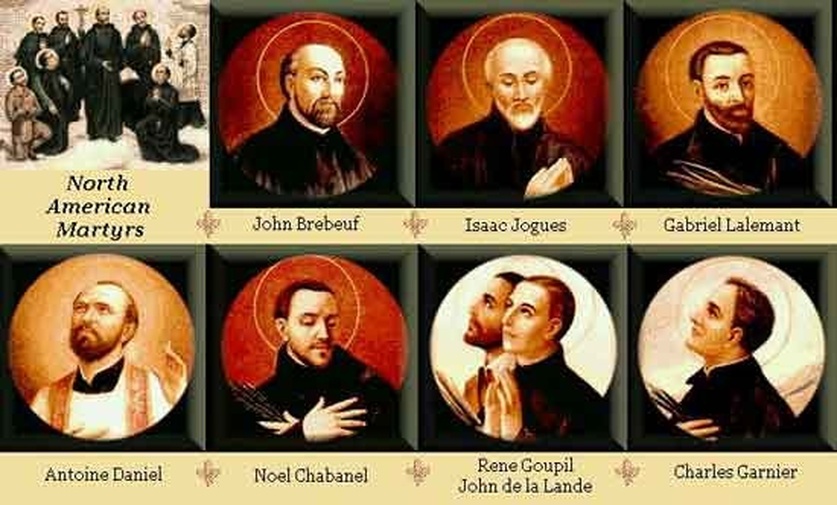Upstate NY Saints
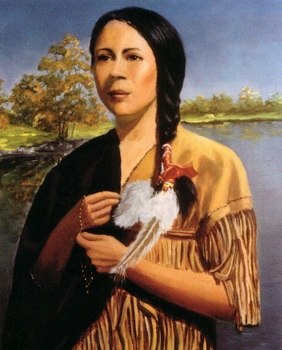
St. Kateri Tekakwitha
St. Kateri’s final words were”Jesus — Mary — I love you” Witnesses reported that within a few minutes of her death, the pock marks from smallpox completely vanished and her face shone with radiant loveliness. Kateri promised her friends that she would continue to love and pray for them in heaven.Fifty years after her death the first convent for Indian nuns was established in Mexico .October 21, 2012 Kateri was canonized as the first native american woman to be honored with sainthood.
Fonda, NY, is the site of the village or “castle” where Kateri lived most of her life. It is the site of the only fully excavated Mohawk village of that era. Nearby, the holy spring, whose water was used to baptize her, still flows here. Many pilgrims claim cures after drawing its crystal clear water and praying through the intercession of Saint Kateri.
http://www.katerishrine.com/history.html
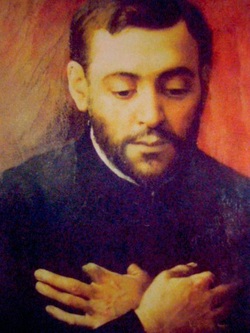
St Isaac Jogues
St. Isaac Jogues encouraged the captives to forgive their captors and offer their sufferings to God on their behalf.
The Hurons were constantly warred upon by the Iroquois, and in a few years Father Jogues was captured by the Iroquois and imprisoned for 13 months. His letters and journals tell how he and his companions were led from village to village, how they were beaten, tortured and forced to watch as their Huron converts were mangled and killed. An unexpected chance for escape came to Isaac Jogues through the Dutch, and he returned to France, bearing the marks of his sufferings. Several fingers had been cut, chewed or burnt off. Pope Urban VIII gave him permission to offer Mass with his mutilated hands: “It would be shameful that a martyr of Christ not be allowed to drink the Blood of Christ.” Welcomed home as a hero, Father Jogues might have sat back, thanked God for his safe return and died peacefully in his homeland. But his zeal led him back once more to the fulfillment of his dreams. In a few months he sailed for his missions among the Hurons.
In 1646 he and Jean de Lalande, who had offered his services to the missioners, set out for Iroquois country in the belief that a recently signed peace treaty would be observed. They were captured by a Mohawk war party, and on October 18 Father Jogues was tomahawked and beheaded. Jean de Lalande was killed the next day at Ossernenon, a village near Albany, New York.
Medicine men blamed the Jesuits for a smallpox epidemic among the Hurons. The French missionaries saw 7,000 + souls converted to Christianity before their deaths. The Church in North America sprang from the blood of martyrs.
http://www.americancatholic.org/features/saints/saint.aspx?id=1173
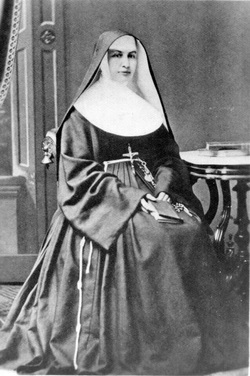
St. Marianne Cope
In 1839, the year following Barbara’s birth(St. Marianne Cope), the family emigrated from Germany to the United States to seek a new start in the land of opportunity.
The family became members of St. Joseph’s Parish in Utica, N.Y., where the children, including Barbara, attended the parish school. Barbara received her first holy communion and was confirmed at St. John’s Parish in Utica.
Later St. Marianne Cope became a champion of patient rights and sanitation- administrator of St. Joseph’s Hospital in Syracuse, N.Y.
In 1883 she became head of sisters in leper colony in Kalaupapa, Hawaii.
”I am hungry for the work and I wish with all my heart to be one of the chosen Ones, whose privilege it will be, to sacrifice themselves for the salvation of the souls of the poor Islanders… I am not afraid of any disease, hence it would be my greatest delight even to minister to the abandoned ‘lepers.’
Though leprosy scared off most people in 19th-century Hawaii, that disease sparked great generosity in the woman who came to be known as Mother Marianne of Molokai. Her courage helped tremendously to improve the lives of its victims in Hawaii. She is the patron saint of lepers, outcasts, and those with HIV/AIDS.
http://blessedmariannecope.org/miracle_case.html
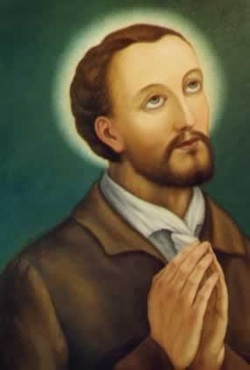
St. René Goupil
René Goupil was born in 1608 in the little village of St. Martin in France. As a young man he became a Jesuit novice with the intention of serving as a lay brother, but ill health prevented him from taking his vows. Skilled in the care of the sick and possessing a practical knowledge of medicine, he ultimately resolved to sail to New France in order to help the Jesuit missionaries he had earlier hoped to join.
Father Isaac Jogues found him working in the Quebec hospital in 1642, and was delighted when he volunteered to travel with him to the Huron country to serve as an infirmarian at Mission Sainte Marie. Both were captured by the ferocious Mohawk Iroquois on the St. Lawrence River, along with a large number of Christian Huron. It was on the torture trail to the Mohawk country that Father Jogues received René’s perpetual vows as a Jesuit brother. Six weeks after their arrival at the village of Ossernenon, René became the first of the eight martyrs to die and thus the first canonized saint of North America.
Buried by the loving hands of Father Jogues himself, René’s holy relics rest in an unmarked grave in the Ravine on the Auriesville Shrine property in upstate New York.
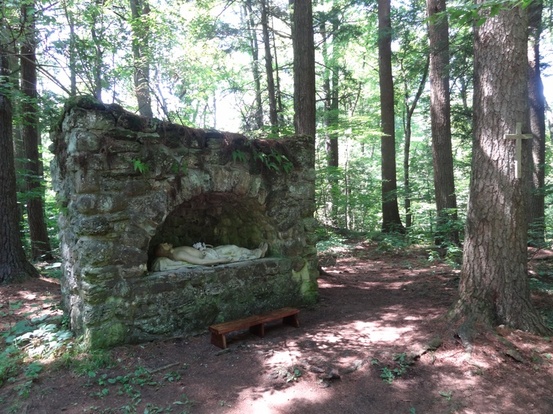
National Shrine of the North American Martyrs Auriesville , Upstate New York. –
Christ Sepulcher in the ravine where Saint Rene Goupil was buried.
http://www.martyrshrine.org/
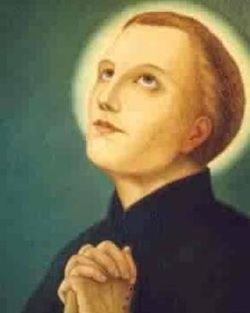
St. Jean de Lalande
Considered one of the North American Martyrs, Jean de Lalande was a French teenager who offered his services to work with the Jesuit missionaries in Canada in the mid-17th century. He served as a companion to Father Isaac Jogues, a French Jesuit priest missionary, on a fated peace mission to Ossernenon, located in upstate New York. Father Jogues had earlier asked for someone who was “virtuous, docile to direction, courageous, one who would be willing to suffer anything for God.” Undeterred by the priest’s description of what was needed, he ultimately endured all of this and more as a captive. St. Jean de Lalande was martyred on October 19, 1646 when he attempted to recover the slain body of Father Jogues from the paths of the village. His faith and heroism were acknowledged by his canonization as a saint of the Church in 1930.
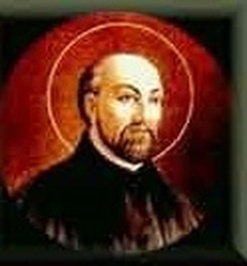
St Jean de Brébeuf
(March 25, 1593 – March 16, 1649)
Brébeuf was killed at St. Ignace in Huronia on March 16, 1649.He had been taken captive with Gabriel Lalemant when the Iroquois destroyed the Huron mission village at Sainte-Louis. The Iroquois took the priests to the occupied village of Taenhatenteron, where they subjected the French men to ritual torture. The Iroquois finally killed them. Five Jesuits: Antoine Daniel, Lalement, Charles Garnier, Noel Charbanel, and Brébeuf, were killed in this conflict.
Throughout the torture, Brébeuf was reported to have been more concerned for the fate of the others and the captive Native converts than for himself. As part of the ritual, the Iroquois drank his blood, as they wanted to absorb Brébeuf’s courage in enduring the pain.The Iroquois mocked baptism by pouring boiling water over his head. They claimed that they were hurting him so that he would be happier in Heaven, as Jesuits preached that “the more one suffers on earth, the happier he is in Heaven”.
The Jesuits Christophe Regnault and Paul Ragueneau provided the two accounts of the deaths of Jean de Brébeuf and Gabriel Lalement. According to Regnault, the Jesuits learned of the tortures and deaths from Huron refugee witnesses, who had escaped from Saint-Marie. Regnault went to see the bodies to verify the accounts, and his superior Rageuneau’s account was based on him. Jesuit accounts of his torture emphasize his stoic nature and acceptance, claiming that he suffered silently without complaining.
Missionaries going to Canada expected to die in the name of God; they believed this was a chance to save converts and be saved. Both were associated with the expansion of Christendom throughout the world.
http://www.newadvent.org/cathen/02751b.htm.
